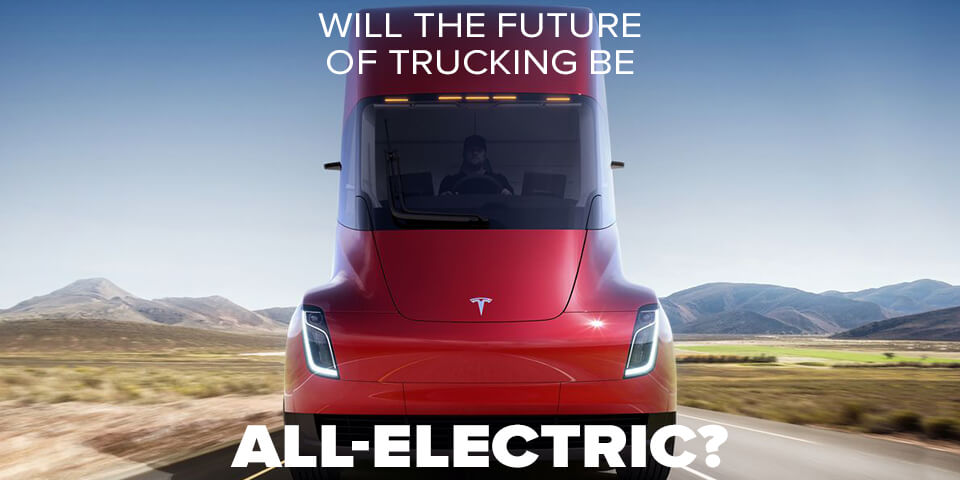In The News

Will the Future of Trucking Be All-Electric? 3 Developments to Watch in 2018
The latest headlines give an impression that trucking—and the automotive industry as a whole—is on the fast-track to full electrification.
Take, for example, the California state legislature, which kicked off the new year by introducing legislation that would ban fossil fuels in the state—presumably in favor of battery-electric and hydrogen fuel-cell systems—by 2040. And this follows similar bans by major global governments, including France and the U.K. (which have also set targets for 2040), along with China (which is targeting its ban for 2030), and Norway (with a 2025 deadline).
In fact, Norway appears to be on track to hit its 2025 target, with all-electric and hybrid-electric vehicles accounting for 52-percent of all new vehicle sales in that country for 2017.
So, what does this mean for trucking? Is the diesel engine—the staple of the heavy-duty trucking sector—really in danger of extinction within the next decade or two?
Here are three developments to watch in 2018 that could offer some insight into those questions and give a glimpse into what an all-electric future in trucking might look like.
#1. Tesla Semi: Will It Deliver?
A lot has happened since we covered the unveiling of the Tesla Semi in November, with several major fleets placing orders for the all-electric Class-8 truck that touts up to 500 miles of range and high-speed charging capabilities that add about 400 miles in 30 minutes. As of press time, early customers for the Tesla Semi include:
- United Parcel Service (UPS)—125 trucks
- PepsiCo—100 trucks
- Anheuser-Busch—40 trucks
- Sysco—50 trucks.
- Walmart—15 trucks.
Tesla said that the Semi's refundable deposits range from $5,000 to $20,000, with an estimated price tag of $150,000 for 300-mile range to $180,000 for 500-miles. Production is to begin in 2019.
What to Watch in 2018:
If Tesla Semi production isn’t until 2019, what should you look for this year? Keep your eyes on the production volume of Model 3, Tesla’s "mass-market” electric sedan. As of press time, production is significantly behind schedule, and if the company can’t course-correct and ramp up production quick enough, Tesla will bleed cash at an even faster rate, causing the equity markets to lose confidence in Tesla, which could drive down the stock price—and the cash levels needed to keep the company afloat.
The bottom line: Production hiccups with Model 3 in 2018 could push Semi production beyond 2019—or lead to the truck model being scrapped altogether. So, watch this space closely.
#2. Chanje Delivery Van: Will the Ryder Partnership Accelerate Fleet Electrification?
In November, Ryder System, Inc. announced that it had started taking delivery of 125 medium-duty electric delivery vans by Chanje Energy, which are now available for lease or rent. These initial Chanje vans, which can haul up to 6,000 pounds with a 100-mile range, will be maintained at Ryder’s maintenance facilities within the California, New York, and Illinois markets where electric vehicle (EV) charging stations are being installed.
Dennis Cooke, president of Global Fleet Management Solutions for Ryder said that the company’s partnership with Chanje would "promote energy efficiency in the industry by allowing our rental and lease customers to implement electric vehicles into their operations on a short-term or long-term basis.”
What to Watch in 2018:
How much demand will there be by Ryder customers to lease or rent the Chanje vans? This is will be interesting to watch. Will Ryder’s business model for these vans prove to be sustainable for the company—and affordable for its customers? Also, will Chanje expand range options beyond 100 miles? If so, that could make the van more useful for more applications in the expedited trucking sector.
The bottom line: This is an interesting development because the van is already production-ready, so we’ll get to see how these vehicles perform in real-world settings. What will be the results? Will the economics of the electric van make enough sense to drive growth in this segment?
#3: Nikola One: Can Hydrogen Solve the Range Problem for Long-Haul Electric Trucking?
While the Tesla Semi would be more appropriate for short to mid-range hauling applications, the Nikola One is being touted as the first all-electric truck option for long-haul routes. That’s because instead of using battery packs like the Tesla model, Nikola One is powered by hydrogen fuel cells that give the truck an all-electric range up to 1,200 miles.
Nikola plans to start with 16 hydrogen fueling stations located in the Midwest and East Coast by 2019. And according to the company, there will be four test trucks running in 2018, with a planned 250 units by 2019 and a total of 750 by 2020. Full production is slated to begin in 2021.
How much does a Nikola One cost? According to reporting by The Drive, Nikola’s business model is to charge customers on a per-mile basis, with a lease program that covers all costs of running the truck—except tag, title and insurance—"from wipers and tires to all maintenance and fuel," at a per-mile cost that’s 20 to 40 percent lower than a diesel semi.
Says Nikola Motors CEO Trevor Milton: “You won’t even be able to buy a diesel in 10 years because you’re going to be losing over a zero-emission vehicle.”
What to Watch in 2018:
Hydrogen fuel-cell technology could help solve the battery-range issue for electric trucks, but will there be sufficient fueling infrastructure to make these trucks viable? There’s a lot of promise behind the concept of this truck—along with Nikola’s bold pay-per-mile all-inclusive business model—but will it work in the real-world?
The bottom line: The company plans to test four trucks this year, ramping up to 250 by 2019. So, it will be interesting to see how much momentum Nikola can generate in 2018 based on the initial data from these tests.
